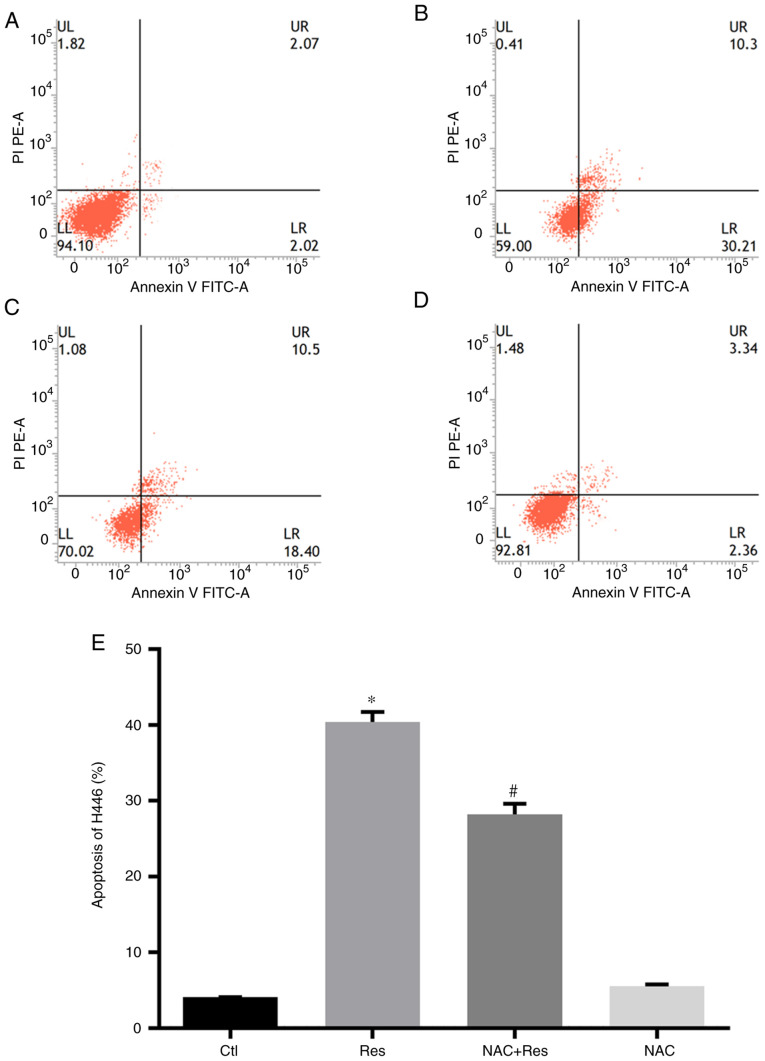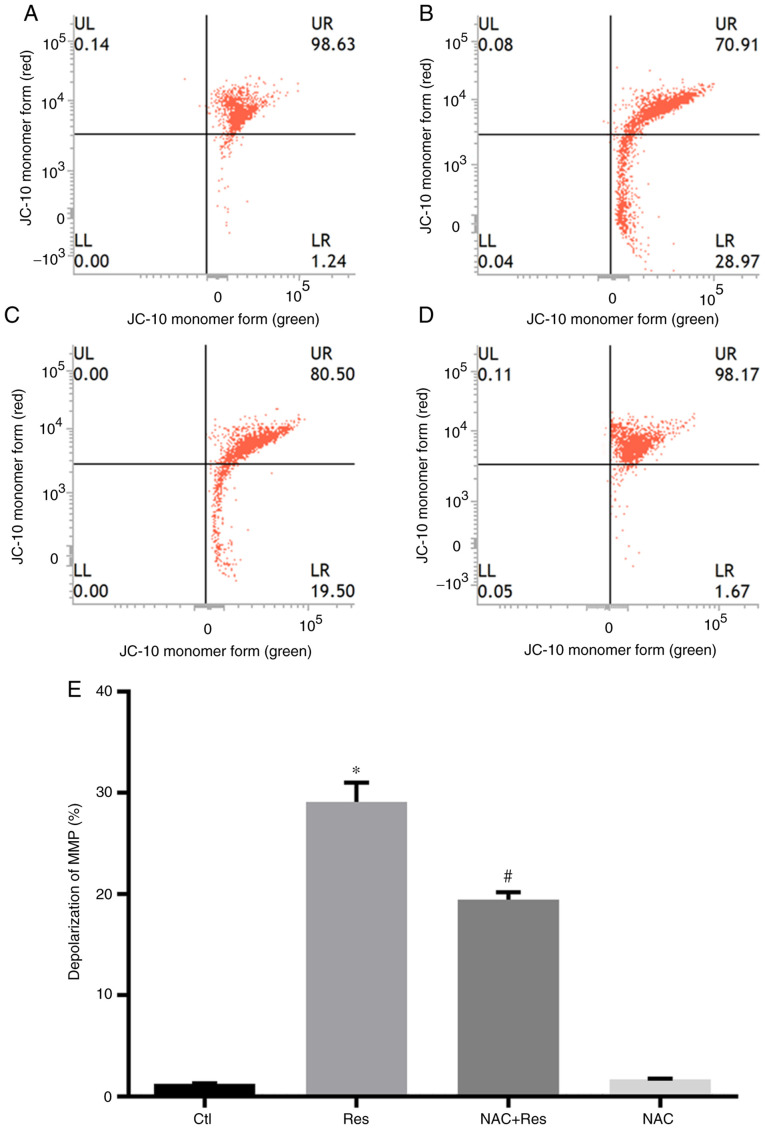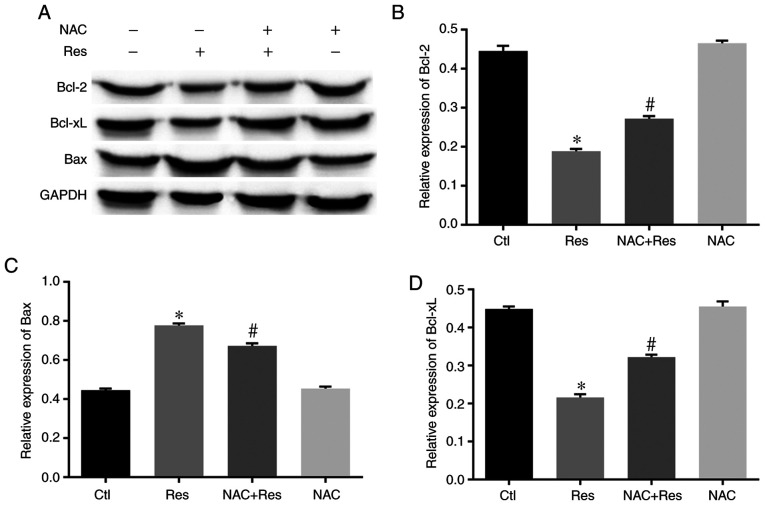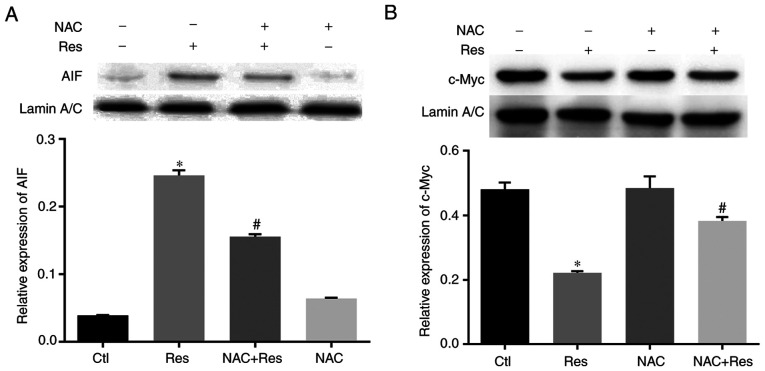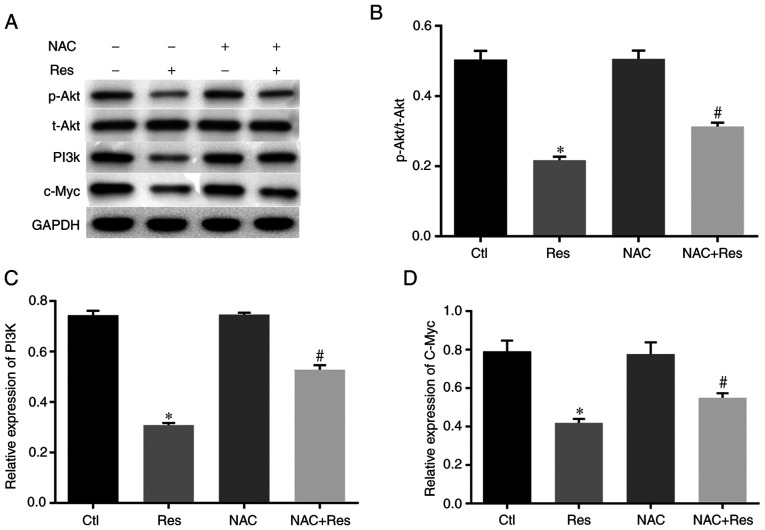Abstract
There have been no major breakthroughs in the treatment of small-cell lung cancer (SCLC) in recent decades. It is thus essential to explore new or adjuvant treatment options for SCLC. Resveratrol (Res) is a natural antioxidant revealed to influence the entire process of cancer development. Accordingly, the present study used the SCLC cell line H446 to explore the antitumor mechanism of Res. Cells were treated with 40 µg/ml Res with or without pretreatment with the antioxidant N-acetyl-L-cysteine (NAC). H446 cell viability and apoptosis were assessed with MTT and flow cytometry, and the expression of cytochrome c and the PI3K/Akt/c-Myc pathway and the nuclear translocation of apoptosis inducing factor (AIF) were assessed by western blotting. In addition, the changes in ROS content and mitochondrial membrane potential were determined. The results revealed that Res inhibited H446 cell viability and induced apoptosis, increased cytochrome c expression, inhibited the expression of PI3K/Akt/c-Myc signaling pathway components, and promoted the translocation of AIF from the cytoplasm to the nucleus in H446 cells. However, NAC pretreatment reversed these changes to various extents. The results of the present study indicated that Res may inhibit the viability and promote the apoptosis of human SCLC H446 cells through the PI3K/Akt/c-Myc pathway and that oxidative stress and mitochondrial membrane potential depolarization may be involved in the aforementioned processes.
Keywords: resveratrol, small-cell lung cancer, PI3K/Akt/c-Myc pathways
Introduction
According to a study by the World Health Organization's International Agency for Research on Cancer (IARC), lung cancer has the highest incidence and mortality of all malignant tumors (1). In the United States, its incidence and mortality in the male population have gradually decreased, the incidence in females has remained unchanged, and the overall mortality rate has exhibited a downward trend (1). However, in China, because the number of smokers is still increasing, the incidence of lung cancer is also increasing. According to an epidemiological survey conducted in 2002, patients aged 65 years or older accounted for 55% of the total number of lung cancers and, among people older than 65 years, the incidence of lung cancer was significantly higher in developed countries than in less developed countries (1). The age of onset of lung cancer has decreased in recent years, with the incidence rate curve tending to move forward by ~5 to 10 years (2). In addition, as the population of China ages, the predicted incidence of lung cancer will continue to rise.
In recent decades, the diagnosis and treatment of lung cancer have considerably improved due to better understanding of lung cancer pathogenesis and clinical treatment research. Treatments for patients with advanced non-small-cell lung cancer (NSCLC) have been sequentially launched and include first-, second-, and third-line mature chemotherapy regimens (3). Notably, targeted therapy with molecular targets as a classification standard has become a milestone in the treatment of NSCLC (4). In contrast to the continually updated iterative treatments for NSCLC, there have been no major breakthroughs in the treatment of small-cell lung cancer (SCLC). Since chemotherapy with or without radiotherapy remains the preferred option for SCLC patients, its failure may significantly reduce survival (3). Therefore, identification of new treatment options or adjuvant treatment options for SCLC has urgent practical needs.
Resveratrol (Res), chemically known as trans−3,4,5-trihydroxystilbene, is a small molecule polyphenolic compound found in the dried rhizomes and roots of the sylvestris plant, the skin and seeds of the fruit of the grape family, legumes, and peanuts. Res is a natural antioxidant with multiple effects that has been used in multi-system research (5). Zeng et al (6) revealed that the anticancer activity of Res affects the entire process of cancer development and can inhibit the proliferation of cancer cells and induce their apoptosis. Our previous research results (7) revealed that Res significantly inhibited the viability of H446 SCLC cells and had a synergistic effect on cisplatin, indicating that their combination could enhance the anticancer effects of cisplatin on H446 cells.
Based on the previous results, the present study further clarified that Res affects cell oxidative stress and mitochondrial membrane potential by interfering with the PI3K/Akt signaling pathway in H446 cells and ultimately inhibits the viability and promotes the apoptosis of H446 cells.
Materials and methods
Cell culture
The human SCLC H446 cell line was provided by the Department of Respiratory and Critical Care Medicine, Tangdu Hospital, Air Force Military Medical University. The cells were cultured in RPMI-1640 medium containing 10% fetal calf serum (Gibco; Thermo Fisher Scientific, Inc.) in a 37°C incubator with 5% CO2. Cells in the logarithmic growth phase were used for the subsequent experimental studies. The cells were randomly divided into a blank control group, Res group, Res+ N-acetyl-L-cysteine (NAC) group, and NAC group. The treatment concentrations of Res and NAC [a reactive oxygen species (ROS) inhibitor] were 40 µg/ml and 2 mmol/l, respectively, in line with our previous research results (7,8). Cells in the Res+NAC group were first treated with 2 mmol/l of NAC for 2 h and then with 40 µg/ml Res for 24 h.
Cell viability assay
Cell viability was assessed by the MTT method. H446 cells in the logarithmic growth phase were seeded in a 96-well plate at a density of 5×104 cells/well. After treatment of the cells in each group, MTT (5 mg/ml, 15 µl/well) was added to each well and incubated at 37°C for 4 h. Then, the culture medium in each well was changed to 200 µl DMSO and the optical density (OD) value of each well was measured at 492 nm using a Bio-Rad 550 microplate reader (Bio-Rad Laboratories, Inc.). Cell survival rates were calculated according to the OD value of each well.
Apoptosis detection
After the various treatments were completed, the cells (1×106) in each group were assessed for apoptosis using flow cytometry. Briefly, the detection process was as follows: Each group of cells was co-incubated with propidium iodide (PI) and Annexin V-FITC solution (BD Biosciences) and processed according to the instructions of the kit. The apoptosis level of each group of cells was examined by flow cytometry (BD FACSVerse™; BD Biosciences) and the results were analyzed by FlowJo (Flow Jo 7.6; Tree Star Inc.).
Intracellular ROS content detection
After the various treatments were completed, the cells (1×106) from each group were collected and the differences in the ROS content of each group were determined by flow cytometry. Briefly, the 2′,7′-dichlorodihydrofluorescein diacetate (DCF-DA) stain (Beyotime Institute of Biotechnology, 10 µmol/l, 20 min of incubation at 37°C) was used to detect the ROS contents of the cells, and the cells were processed according to the instructions of the kit. The fluorescence intensity of DCF was detected by flow cytometry (BD-FACSVerse; BD Biosciences), and the average DCF intensity level was considered as a reflection of the ROS content of the cells in each group.
Mitochondrial membrane potential detection
After the various treatments were completed, the cells (1×106) from each group were collected, stained with 10 µg/ml tetrachloro-tetraethyl benzimidazol carbocyanine iodide (JC-1; Abcam), and incubated at 37°C for 45 min. Flow cytometry (BD-FACSVerse; BD Biosciences) was used to determine and FlowJo (Flow Jo 7.6; Tree Star Inc.) was used to analyze the mitochondrial membrane potential (MMP) in the cells of each group according to the instructions.
Western blotting
The aforementioned groups of cells were collected and the expression levels of the target proteins in each group were determined by western blotting. Total protein and nuclear protein were extracted according to the procedure of the Protein Extraction Kit (BestBio Institute of Biotechnology). The concentration of each protein sample was analyzed by the BCA method and samples were stored at −20°C after denaturation. A 12% SDS-PAGE separation gel was prepared, and 20 µg of the protein sample was subjected to SDS-PAGE and then transferred to a PVDF membrane (EMD Millipore). The PVDF membrane was blocked in TBST containing 5% skim milk powder (blocking solution) at room temperature for 2 h, and then the corresponding primary antibody (Table I) was diluted in the blocking solution to the desired concentration and incubated at 4°C overnight. After three washes with the TBST solution, the PVDF membrane was placed in a secondary antibody solution for 2 h at room temperature. The protein expression signals were detected using an ECL detection system (ChemiScope 5300 Pro; CLiNX) and analyzed by ImageJ (version 1.8.0; National Institutes of Health).
Table I.
Antibodies used in the present study.
| Antibody | Source | Dilution ratio | Catalogue no. | Supplier |
|---|---|---|---|---|
| Anti-Bcl-2 | Mouse | 1:2,000 | ab182858 | Abcam |
| Anti-Bcl-xL | Rabbit | 1:2,000 | ab178844 | Abcam |
| Anti-Bax | Rabbit | 1:2,000 | ab32503 | Abcam |
| Anti-cyto-c | Rabbit | 1:1,000 | ab13575 | Abcam |
| Anti-AIF | Mouse | 1:1,000 | PBO388 | Boster |
| Anti-p-Akt | Rabbit | 1:1,000 | ab38449 | Abcam |
| Anti-t-Akt | Rabbit | 1:2,000 | ab176463 | Abcam |
| Anti-PI3K | Rabbit | 1:2,000 | ab140347 | Abcam |
| Anti-GAPDH | Rabbit | 1:5,000 | ab181602 | Abcam |
| Anti-Lamin A/C | Rabbit | 1:5,000 | GB11407 | Servicebio |
| Goat anti-rabbit IgG | Goat | 1:4,000 | BL003A | BioSharp |
| Rabbit anti-mouse IgG | Rabbit | 1:4,000 | BL001A | BioSharp |
Statistical analysis
Statistical analysis was performed with GraphPad Prism 6 (GraphPad Software, Inc.). Numerical variables are expressed as the means ± standard deviations. Statistical differences among experimental conditions were assessed by one-way analysis of variance (ANOVA) followed by Dunnett's test. P<0.05 was considered to indicate a statistically significant difference.
Results
Effect of Res on the survival rate of H446 cells
The cell survival rate of the blank control group (Ctl) was regarded as ‘1’, and the OD values of the Res group, the Res+NAC group, and the NAC group were compared with that of the Ctl group, allowing calculation of the relative viability inhibition rates of the cells in each group. As revealed in Fig. 1, the viability inhibition rate of 40 µg/ml Res in H446 cells was 51.33% (P<0.05 vs. the Ctl). After pretreatment with NAC, the viability inhibition rate of 40 µg/ml Res decreased to 36.61%. There was also a statistically significant decrease in the viability inhibition rate of H446 cells in the NAC+Res group compared with the Res group (P<0.05), but there was no significant effect on cell survival with 2 mmol/l NAC alone.
Figure 1.
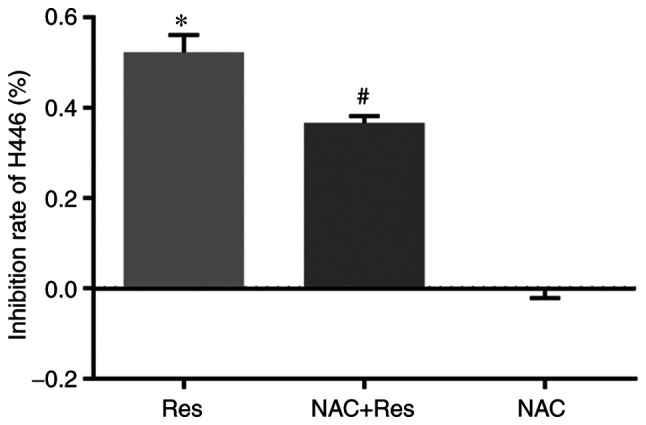
Effects of Res on the survival rate of H446 cells are evaluated by MTT assay. The results were expressed as the mean ± standard deviation of at least 3 separate experiments. Res at 40 µg/ml significantly inhibited H446 cell viability (*P<0.05 vs. the control), and the inhibition of 40 µg/ml Res was significantly higher than that of 2 mmol/l NAC and 40 µg/ml Res (#P<0.05 vs. the Res group). Res, resveratrol; NAC, N-acetyl-L-cysteine.
Effect of Res on H446 cell apoptosis
Flow cytometry was used to determine the effect of Res on the apoptosis of H446 cells with or without NAC pretreatment. As revealed in Fig. 2, the apoptosis rate was 40.39% in H446 cells when they were stimulated by 40 µg/ml Res for 24 h, which was significantly higher than that in the Ctl group (P<0.05). However, after pretreatment with NAC, 24 h of Res treatment resulted in 28.23% apoptosis in H446 cells. In addition, compared with the Res group, the NAC+Res group was significantly decreased (P<0.05). Treatment with 2 mmol/l NAC had no marked effect on apoptosis in H446 cells.
Figure 2.
Effects of Res on H446 cell apoptosis are detected by flow cytometry. The results were expressed as the mean ± standard deviation of at least 3 separate experiments. (A-D) representative flow cytometric histograms of cell apoptosis analysis from the control (Ctl), Res, NAC+Res and NAC groups, respectively. (E) Results of cell apoptosis analysis. Res at 40 µg/ml increased the percentage of apoptotic cells compared with that of the control (*P<0.05), while pretreatment of NAC at 2 mmol/l decreased the amount of apoptosis in cells stimulated by Res (#P<0.05 vs. the Res group). Res, resveratrol; NAC, N-acetyl-L-cysteine.
Effect of Res on ROS production in H446 cells
Since Res inhibited the viability of H446 cells and promoted their apoptosis, the effect of Res on ROS levels in H446 cells was further examined. The results are presented in Fig. 3. Following Res treatment, the level of ROS in H446 cells was significantly increased, reaching ~16 times that of the Ctl group (P<0.05). In addition, Res treatment also increased the ROS content in NAC-pretreated H446 cells, which was 12.10 times that of the Ctl. However, the ROS level in cells from the NAC+Res group was still significantly lower than that of the Res group (P<0.05). Treatment of cells with NAC alone had no significant effect on the level of ROS in H446 cells.
Figure 3.
Effect of Res on ROS production in H446 cells is detected by flow cytometry. The results were expressed as the mean ± standard deviation of at least 3 separate experiments. (A-D) Representative flow cytometric histograms of ROS content from the control (Ctl), Res, NAC+Res and NAC groups groups, respectively. (E) Results of ROS generation analysis. Res at 40 µg/ml increased the content of ROS compared with that of control (*P<0.05), while pretreatment of NAC at 2 mmol/l decreased the generation of ROS in cells stimulated by Res (#P<0.05 vs. the Res group). Res, resveratrol; ROS, reactive oxygen species; NAC, N-acetyl-L-cysteine.
Effect of Res on the MMP of H446 cells
After confirming that Res inhibited the viability of H446 cells and promoted apoptosis in a manner that was related to ROS production, the changes in the MMP of H446 cells treated with Res were further examined. Res at 40 µg/ml increased the amount of H446 cells with depolarized MMP by 29.13% compared with the Ctl group (P<0.05; Fig. 4). While pretreatment of NAC at 2 mmol/l alleviated the effects of Res on depolarization of MMP to 19.44% compared with that of Ctl group. Statistical analysis also revealed that the NAC+Res group was significantly lower compared with the Res group (P<0.05). NAC treatment alone had no significant effect on the MMP of H446 cells.
Figure 4.
Depolarization of the MMP in H446 cells was evaluated by flow cytometry. (A-D) Representative flow cytometric histograms of MMP from the control (Ctl), Res, NAC+Res and NAC groups, respectively. (E) Results of MMP analysis. Res at 40 µg/ml increased the amount of H446 cells with depolarized MMP compared with that of the control (*P<0.05), while pretreatment of NAC at 2 mmol/l alleviated the effects of Res on depolarization of MMP in cells stimulated by Res (#P<0.05 vs. the Res group). MMP, mitochondrial membrane potential; Res, resveratrol; NAC, N-acetyl-L-cysteine.
Effect of Res on the expression of apoptotic proteins in H446 cells
After confirming that Res inhibited the viability of H446 cells and promoted apoptosis through ROS production and MMP, the effect of Res on the expression of apoptosis-related proteins was further explored in H446 cells. As revealed in Fig. 5, after Res treatment of H446 cells, the expression of Bcl-2 and Bcl-xL was significantly lower than that of the Ctl group (P<0.05). However, after pretreatment with NAC, the expression of Bcl-2 and Bcl-xL in the NAC+Res group was significantly higher than that of the Res group (P<0.05). In contrast to the expression of Bcl-2 and Bcl-xL, the expression of Bax in H446 cells was significantly increased after Res treatment compared with the Ctl group (P<0.05). Conversely, NAC pretreatment significantly alleviated the increase in Bax expression in Res-stimulated H446 cells (P<0.05).
Figure 5.
Effect of Res on the expression of apoptotic proteins in H446 cells are assessed by western blotting. (A-D) Res at 40 µg/ml decreased the expression of (B) Bcl-2 and (D) Bcl-xL while it increased (C) Bax expression compared with that of the control (*P<0.05). By contrast, pretreatment of NAC at 2 mmol/l alleviated the effects of Res on the expression of Bcl-2, Bax and Bcl-xL, respectively (#P<0.05 vs. the Res group). Res, resveratrol; NAC, N-acetyl-L-cysteine.
Effect of Res on the cytoplasmic expression of cytochrome C in H446 cells
Based on the aforementioned results, the effect of Res on the expression of cytochrome c (cyto-c) in the H446 cytoplasm was further explored. Western blot analysis (Fig. 6A and B) revealed that the expression of cyto-c in the H446 cytoplasm was significantly higher in Res-treated cells than in the control group (P<0.05). However, in the NAC-pretreated N446 cells, the cytoplasmic expression of cyto-c was significantly lower than that of the Res group (P<0.05). NAC alone had no significant effect on the expression of cyto-c in H446 cells.
Figure 6.
Effects of Res on the expression of cyto-c and AIF in the H446 cytoplasm are assessed by western blotting. (A) Groups and representative bands. Res at 40 µg/ml increased the expression of (A and B) cyto-c and decreased the expression of (A and C) AIF in the H446 cytoplasm compared with the control (*P<0.05). While pretreatment of NAC at 2 mmol/l decreased the expression of cyto-c and increased the AIF expression in H446 cytoplasm stimulated with 40 µg/ml Res (#P<0.05 vs. the Res group). Res, resveratrol; Cyto-c, cytochrome c; AIF, apoptosis inducing factor; NAC, N-acetyl-L-cysteine.
Effect of Res on the expression of AIF in H446 cells
The effect of Res stimulation on AIF expression in H446 cells was further examined. The results revealed that the cytoplasmic expression of AIF was significantly lower in Res-stimulated cells than in the control group (P<0.05) (Fig. 6A and C). However, the expression of AIF in the NAC+Res group was significantly higher than that of the Res group (P<0.05). In contrast, analysis of AIF expression in the nuclear fraction of H446 cells (Fig. 7A) revealed that Res stimulation increased the nuclear AIF expression of H446 cells compared with the control group (P<0.05) and the expression of AIF in the NAC+Res group was significantly lower than that of the Res group (P<0.05). In addition, NAC treatment alone had no significant effect on the expression of AIF in the H446 cytoplasm or nucleus.
Figure 7.
Effects of Res on the expression of (A) AIF and (B) c-Myc expression in H446 cell nuclear fractions were measured by western blotting. Res at 40 µg/ml increased AIF expression in nuclear fractions of H446 cells (*P<0.05) while it decreased the expression of c-Myc in nuclear fractions (*P<0.05) compared with that of control. Conversely, NAC at 2 mmol/l alleviated the effects of Res on the expression of AIF and c-Myc in H446 nuclear fractions (#P<0.05 vs. the Res group). Res, resveratrol; AIF, apoptosis inducing factor; NAC, N-acetyl-L-cysteine.
Effect of Res on the expression of PI3K/Akt signaling pathway components
Based on the aforementioned experiments, the mechanism by which Res affects SCLC H446 cells and its effect on the PI3K/Akt signaling pathway were further investigated. As revealed in Fig. 8A-C, the expression levels of PI3K and p-Akt were significantly decreased in Res-stimulated H446 cells (P<0.05 vs. the Ctl), the expression of p-Akt and PI3K in the NAC+Res group was significantly higher than that of the Res group (P<0.05). In addition, we assessed the expression of c-Myc in H446 cells. The results (Fig. 7B and 8D) revealed that Res stimulation decreased the expression of c-Myc in both the cytoplasm and nucleus but the expression of c-Myc in the NAC+Res group was higher than that of Res group (P<0.05).
Figure 8.
Effects of Res on the Akt, PI3K and c-Myc expression in H446 cells are evaluated by western blotting. (A) Groups and representative bands. Res at 40 µg/ml decreased the expression of (B) p-Akt, (C) PI3K and (D) c-Myc in total protein fractions compared with that of control (*P<0.05). By contrast, pretreatment of NAC at 2 mmol/l alleviated the inhibition of Res on the expression of p-Akt, PI3K and c-Myc (#P<0.05 vs. the Res group). Res, resveratrol; NAC, N-acetyl-L-cysteine.
Discussion
SCLC is a major type of primary malignant tumor in the lungs, accounting for 15–20% of all lung cancers. This cancer subtype has a high degree of malignancy, is prone to recurrence and metastasis, and has a short survival period. A platinum-based double-drug chemotherapy regimen has been recommended as the standard treatment for lung cancer since its first application in the 1970s, but it has not fundamentally improved the survival and recovery of patients with SCLC (3). Res is a natural plant-derived compound widely found in nature (9). Since its recognition, considerable research into its bioactivity has been conducted (10). A number of studies have found that Res has potential anticancer activity in tumors of multiple systems in the human body (6,11), although there are few studies on the anticancer effects of Res in lung cancer. Previous research by our group revealed that Res concentration- and time-dependently decreased the viability of H446 cells, promoted their apoptosis through the mitochondrial apoptosis pathway, and boosted the antitumor effect of cisplatin on H446 cells (7).
In our previous research, the relationship between the concentration of Res and toxicity in H446 cells was explored, confirming that Res has potent toxic effects on the SCLC H446 cell line (7). Based on these findings, 40 µg/ml Res was used in the present study to further explore the anticancer effects of Res in H446 cells. It was confirmed that 40 µg/ml Res caused morphological damage, inhibited proliferation, and induced the apoptosis of H446 cells. However, NAC pretreatment attenuated the morphological changes and reduced the proliferative capacity of Res-treated H446 cells. NAC is an antioxidant that can significantly reduce the oxidative stress response of tissues and cells (12). Therefore, the present results further confirmed that the antitumor effects of Res were related to oxidative stress.
ROS play a key role in regulating apoptosis, and the aim of chemotherapy strategies is to alter the oxidative and antioxidant balance by increasing ROS production in tumor cells, which can further lead to tumor cell apoptosis (13). Excessive ROS production decreases the MMP (14). Mitochondria are dynamic intracellular organelles that provide 95% of the adenosine triphosphate (ATP) required by the human body (15). A normal MMP is critical for oxidative phosphorylation and ATP production, and a reduced MMP is a hallmark of various early apoptotic pathways (16). In the present study, Res-treated H446 cells generated more ROS than control cells and experienced more apoptosis, as well as an MMP decrease. Conversely, after pretreatment with NAC, Res-induced ROS production and MMP depolarization were ameliorated to some extent, and assessment of apoptosis also revealed that NAC reduced the number of apoptotic H446 cells after Res treatment.
A lower MMP is often followed by the release of cyto-c from the mitochondria to the cytoplasm (17), which mediates apoptosis with the participation of Bcl-2 family proteins (18). Bcl-2 and Bcl-xL are generally considered to play a role in preventing apoptosis and cell death caused by various stressors (19). In contrast, Bax homodimers with sequence homology to Bcl-2 are important pro-apoptotic proteins (20). The results of the present study indicated that Res stimulation promoted the release of cyto-c from the mitochondria to the cytoplasm while increasing the expression of the pro-apoptotic protein Bax and decreasing the expression of the antiapoptotic proteins Bcl-2 and Bcl-xL. AIF is a redox active enzyme on the mitochondrial membrane that would be released into the cytoplasm and then enter the nucleus after depolarization of the MMP. Once the AIF enters the nucleus, the DNA is cleaved into 50-kb fragments and then caspase family-independent apoptosis is triggered (21). After Res treatment of H446 cells, the cytoplasmic expression of AIF decreased while its nuclear expression increased, which is consistent with a study of AIF involvement in apoptosis (22). After NAC treatment, the inductive effect of Res on the release of cyto-c and expression of Bax in H446 cells was alleviated. Concurrently, Bcl-2 and Bcl-xL expression levels were maintained at a relatively high level. In addition, Res slightly reversed the change in AIF expression. These results are consistent with our previous results (7) and those of other researchers examining the antitumor mechanism of Res (23).
The PI3K/Akt pathway is an important intracellular signaling pathway that governs the cell cycle and is directly involved in regulating numerous cell processes, including cell growth, proliferation, differentiation, and migration (24). Phosphorylated Akt (p-Akt) activates or inhibits downstream target proteins such as mTOR, caspase-9, NF-κB, and p21 that are involved in cell proliferation (25). The expression of p-Akt is increased in approximately 50% of SCLCs, and its overexpression is associated with the prognosis of lung cancer. p-Akt inhibits the Bcl family members Bad and Bax, inhibits p53-mediated apoptosis, activates NF-κB, and increases the expression of Bcl-2 and Bcl-xL (26). In the present study it was revealed that Res stimulation significantly decreased the expression levels of PI3K and p-Akt in H446 cells, which was consistent with its effects on cell viability and apoptosis and the expression of related proteins. In addition, NAC pretreatment alleviated the inhibitory effects of Res on PI3K and p-Akt expression. c-Myc regulates the glycolytic activity of tumors (27) and is a key downstream molecule in the PI3K/Akt pathway (28). Overexpression of c-Myc has been observed in multiple tumors (23), and inhibition of c-Myc could inhibit the malignant biological behavior of tumor cells (29). The present results indicated that Res stimulation decreased the expression of c-Myc in both the cytoplasm and nucleus of H446 cells, which was consistent with our anticancer results for Res as well as those in another study (30). However, the effect of Res on c-Myc was markedly inhibited after NAC pretreatment, indicating that Res exerts its antitumor effect through oxidative stress.
In summary, the results from the present study indicated that Res inhibited the viability and promoted the apoptosis of human SCLC H446 cells, which may be related to the oxidative stress level and abnormal mitochondrial membrane potential of H446 cells during Res stimulation. Moreover, Res may exert its antitumor effects through the PI3K/Akt/c-Myc pathway.
Acknowledgements
Not applicable.
Glossary
Abbreviations
- SCLC
small-cell lung cancer
- Res
resveratrol
- NAC
N-acetyl-L-cysteine
- OD
optical density
- PI
propidium iodide
- DCF-DA
2′,7′-dichlorodihydrofluorescein diacetate
- JC-1
tetrachloro-tetraethyl benzimidazol carbocyanine iodide
- MMP
mitochondrial membrane potential
- cyto-c
cytochrome c
Funding
No funding was received.
Availability of data and materials
All data generated or analyzed during this study are included in this published article.
Authors' contributions
LM designed the research and revised the manuscript. FJ was involved in the conception of the study and helped modifying the manuscript. WL and CL were the major contributors in conducting the experiments, interpreting the data and drafting the manuscript All authors read and approved the final manuscript and agree to be accountable for all aspects of the work in ensuring that questions related to the accuracy or integrity of any part of the work are appropriately investigated and resolved.
Ethics approval and consent to participate
Not applicable.
Patient consent for publication
Not applicable.
Competing interests
The authors declare that they have no competing interests
References
- 1.Siegel RL, Miller KD, Jemal A. Cancer statistics, 2017. CA Cancer J Clin. 2017;67:7–30. doi: 10.3322/caac.21387. [DOI] [PubMed] [Google Scholar]
- 2.Burns DM, Anderson CM, Gray N. Has the lung cancer risk from smoking increased over the last fifty years? Cancer Causes Control. 2011;22:389–397. doi: 10.1007/s10552-010-9708-1. [DOI] [PMC free article] [PubMed] [Google Scholar]
- 3.Geddes D. The history of respiratory disease management. Medicine (Abingdon) 2020;48:239–243. doi: 10.1016/j.mpmed.2020.01.007. [DOI] [PMC free article] [PubMed] [Google Scholar]
- 4.Blumenthal GM, Zhang L, Zhang H, Kazandjian D, Khozin S, Tang S, Goldberg K, Sridhara R, Keegan P, Pazdur R. Milestone analyses of immune checkpoint inhibitors, targeted therapy, and conventional therapy in metastatic non-small cell lung cancer trials: A meta-analysis. JAMA Oncol. 2017;3:e171029. doi: 10.1001/jamaoncol.2017.1029. [DOI] [PMC free article] [PubMed] [Google Scholar]
- 5.Cucciolla V, Borriello A, Oliva A, Galletti P, Zappia V, Della Ragione F. Resveratrol: From basic science to the clinic. Cell Cycle. 2007;6:2495–2510. doi: 10.4161/cc.6.20.4815. [DOI] [PubMed] [Google Scholar]
- 6.Zeng Y, Li FD, Shi CW, Du JL, Xue YJ, Liu XY, Cao X, Wei N. Mechanism and therapeutic prospect of resveratrol combined with TRAIL in the treatment of renal cell carcinoma. Cancer Gene Ther. 2019 Oct 30; doi: 10.1038/s41417-019-0150-6. (Epub ahead of print) [DOI] [PubMed] [Google Scholar]
- 7.Li W, Shi Y, Wang R, Pan L, Ma L, Jin F. Resveratrol promotes the sensitivity of small-cell lung cancer H446 cells to cisplatin by regulating intrinsic apoptosis. Int J Oncol. 2018;53:2123–2130. doi: 10.3892/ijo.2018.4533. [DOI] [PubMed] [Google Scholar]
- 8.Wang R, Ma L, Weng D, Yao J, Liu X, Jin F. Gallic acid induces apoptosis and enhances the anticancer effects of cisplatin in human small cell lung cancer H446 cell line via the ROS-dependent mitochondrial apoptotic pathway. Oncol Rep. 2016;35:3075–3083. doi: 10.3892/or.2016.4690. [DOI] [PubMed] [Google Scholar]
- 9.Ahmadi R, Ebrahimzadeh MA. Resveratrol-A comprehensive review of recent advances in anticancer drug design and development. Eur J Med Chem. 2020;200:112356. doi: 10.1016/j.ejmech.2020.112356. [DOI] [PubMed] [Google Scholar]
- 10.Muniraj N, Siddharth S, Sharma D. Bioactive compounds: Multi-targeting silver bullets for preventing and treating breast cancer. Cancers (Basel) 2019;11:1563. doi: 10.3390/cancers11101563. [DOI] [PMC free article] [PubMed] [Google Scholar]
- 11.Ashrafizadeh M, Ahmadi Z, Farkhondeh T, Samarghandian S. Resveratrol targeting the Wnt signaling pathway: A focus on therapeutic activities. J Cell Physiol. 2020;235:4135–4145. doi: 10.1002/jcp.29327. [DOI] [PubMed] [Google Scholar]
- 12.Wu H, Tong C. Ratiometric fluorometric determination of silver(I) by using blue-emitting silicon- and nitrogen-doped carbon quantum dots and red-emitting N-acetyl-L-cysteine-capped CdTe quantum dots. Mikrochim Acta. 2019;186:723. doi: 10.1007/s00604-019-3818-6. [DOI] [PubMed] [Google Scholar]
- 13.Liou GY, Storz P. Reactive oxygen species in cancer. Free Radic Res. 2010;44:479–496. doi: 10.3109/10715761003667554. [DOI] [PMC free article] [PubMed] [Google Scholar]
- 14.Zamzami N, Marchetti P, Castedo M, Decaudin D, Macho A, Hirsch T, Susin SA, Petit PX, Mignotte B, Kroemer G. Sequential reduction of mitochondrial transmembrane potential and generation of reactive oxygen species in early programmed cell death. J Exp Med. 1995;182:367–377. doi: 10.1084/jem.182.2.367. [DOI] [PMC free article] [PubMed] [Google Scholar]
- 15.Hamada M, Sumida M, Okuda H, Watanabe T, Nojima M, Kuby SA. Adenosine triphosphate-adenosine-5′-monophosphate phosphotransferase from normal human liver mitochondria. Isolation, chemical properties, and immunochemical comparison with Duchenne dystrophic serum aberrant adenylate kinase. J Biol Chem. 1982;257:13120–13128. [PubMed] [Google Scholar]
- 16.Kalpage HA, Bazylianska V, Recanati MA, Fite A, Liu J, Wan J, Mantena N, Malek MH, Podgorski I, Heath EI, et al. Tissue-specific regulation of cytochrome c by post-translational modifications: respiration, the mitochondrial membrane potential, ROS, and apoptosis. FASEB J. 2019;33:1540–1553. doi: 10.1096/fj.201801417R. [DOI] [PMC free article] [PubMed] [Google Scholar]
- 17.Liu Y, Dong X, Wang W, You L, Yin X, Yang C, Sai N, Leng X, Ni J. Molecular mechanisms of apoptosis in HepaRG cell line induced by polyphyllin VI via the Fas death pathway and mitochondrial-dependent pathway. Toxins (Basel) 2018;10:201. doi: 10.3390/toxins10050201. [DOI] [PMC free article] [PubMed] [Google Scholar]
- 18.Samarghandian S, Nezhad MA, Mohammadi G. Role of caspases, Bax and Bcl-2 in chrysin-induced apoptosis in the A549 human lung adenocarcinoma epithelial cells. Anticancer Agents Med Chem. 2014;14:901–909. doi: 10.2174/1871520614666140209144042. [DOI] [PubMed] [Google Scholar]
- 19.Wang W, Guo Q, You Q, Zhang K, Yang Y, Yu J, Liu W, Zhao L, Gu H, Hu Y, et al. Involvement of bax/bcl-2 in wogonin-induced apoptosis of human hepatoma cell line SMMC-7721. Anticancer Drugs. 2006;17:797–805. doi: 10.1097/01.cad.0000217431.64118.3f. [DOI] [PubMed] [Google Scholar]
- 20.Yang B, Johnson TS, Thomas GL, Watson PF, Wagner B, Furness PN, El Nahas AM. A shift in the Bax/Bcl-2 balance may activate caspase-3 and modulate apoptosis in experimental glomerulonephritis. Kidney Int. 2002;62:1301–1313. doi: 10.1111/j.1523-1755.2002.kid587.x. [DOI] [PubMed] [Google Scholar]
- 21.Ding L, Li J, Li W, Fang Z, Li N, Wu S, Li J, Hong M. p53- and ROS-mediated AIF pathway involved in TGEV-induced apoptosis. J Vet Med Sci. 2018;80:1775–1781. doi: 10.1292/jvms.18-0104. [DOI] [PMC free article] [PubMed] [Google Scholar]
- 22.Liang T, Xu X, Ye D, Chen W, Gao B, Huang Y. Caspase/AIF/apoptosis pathway: A new target of puerarin for diabetes mellitus therapy. Mol Biol Rep. 2019;46:4787–4797. doi: 10.1007/s11033-019-04925-1. [DOI] [PMC free article] [PubMed] [Google Scholar]
- 23.Yuan L, Zhou M, Huang D, Wasan HS, Zhang K, Sun L, Huang H, Ma S, Shen M, Ruan S. Resveratrol inhibits the invasion and metastasis of colon cancer through reversal of epithelial- mesenchymal transition via the AKT/GSK-3β/Snail signaling pathway. Mol Med Rep. 2019;20:2783–2795. doi: 10.3892/mmr.2019.10528. [DOI] [PMC free article] [PubMed] [Google Scholar]
- 24.Zoncu R, Efeyan A, Sabatini DM. mTOR: From growth signal integration to cancer, diabetes and ageing. Nat Rev Mol Cell Biol. 2011;12:21–35. doi: 10.1038/nrm3025. [DOI] [PMC free article] [PubMed] [Google Scholar]
- 25.Martini M, De Santis MC, Braccini L, Gulluni F, Hirsch E. PI3K/AKT signaling pathway and cancer: An updated review. Ann Med. 2014;46:372–383. doi: 10.3109/07853890.2014.912836. [DOI] [PubMed] [Google Scholar]
- 26.Manning BD, Toker A. AKT/PKB signaling: Navigating the network. Cell. 2017;169:381–405. doi: 10.1016/j.cell.2017.04.001. [DOI] [PMC free article] [PubMed] [Google Scholar]
- 27.An J, Li F, Qin Y, Zhang H, Ding S. Low concentrations of FA exhibits the hormesis effect by affecting cell division and the warburg effect. Ecotoxicol Environ Saf. 2019;183:109576. doi: 10.1016/j.ecoenv.2019.109576. [DOI] [PubMed] [Google Scholar]
- 28.Zhang HF, Wu C, Alshareef A, Gupta N, Zhao Q, Xu XE, Jiao JW, Li EM, Xu LY, Lai R. The PI3K/AKT/c-MYC axis promotes the acquisition of cancer stem-like features in esophageal squamous cell carcinoma. Stem Cells. 2016;34:2040–2051. doi: 10.1002/stem.2395. [DOI] [PubMed] [Google Scholar]
- 29.Zhang F, Li K, Yao X, Wang H, Li W, Wu J, Li M, Zhou R, Xu L, Zhao L. A miR-567-PIK3AP1-PI3K/AKT-c-Myc feedback loop regulates tumour growth and chemoresistance in gastric cancer. Ebiomedicine. 2019;44:311–321. doi: 10.1016/j.ebiom.2019.05.003. [DOI] [PMC free article] [PubMed] [Google Scholar]
- 30.Ko JH, Sethi G, Um JY, Shanmugam MK, Arfuso F, Kumar AP, Bishayee A, Ahn KS. The role of resveratrol in cancer therapy. Int J Mol Sci. 2017;18:2589. doi: 10.3390/ijms18122589. [DOI] [PMC free article] [PubMed] [Google Scholar]
Associated Data
This section collects any data citations, data availability statements, or supplementary materials included in this article.
Data Availability Statement
All data generated or analyzed during this study are included in this published article.



